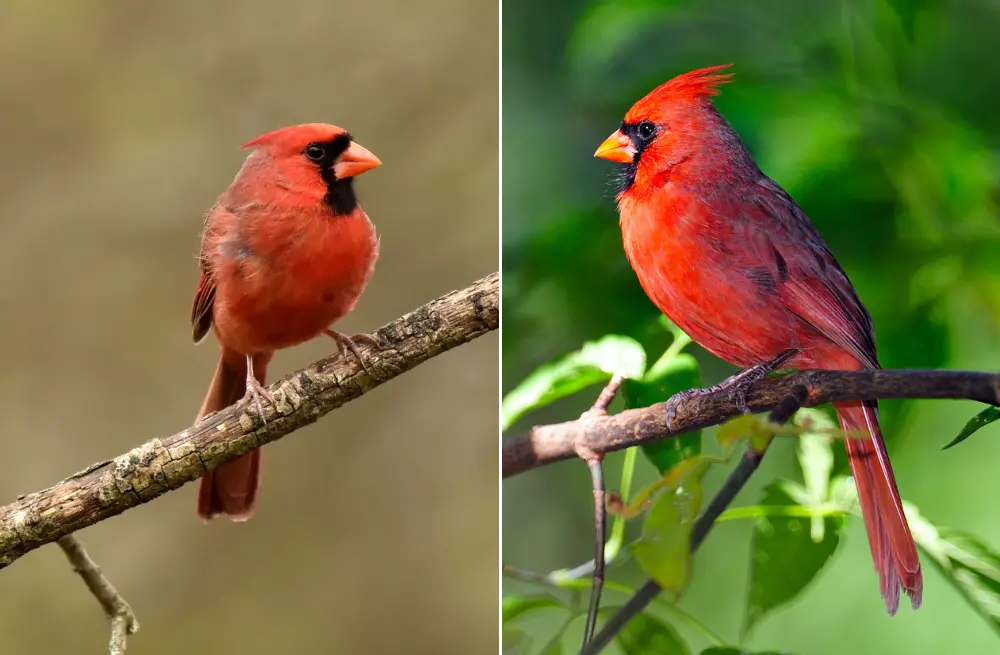The crested canary is not your average songbird. While many canaries are celebrated for their melodious tunes or dazzling hues, the crested canary is adored for its distinctive silhouette, particularly the elegant plume atop its head.
This singular feature not only gives this breed its name but also sets it apart from the myriad of “type” canaries bred for unique physical attributes. Beyond its regal appearance, the crested canary boasts a delightful personality, captivating bird enthusiasts and casual observers alike.
Diverging from the quintessential image of a yellow songbird, the crested canary proudly showcases its feathered crown, asserting its unique position in the bird kingdom.
Dive with me into the captivating world of the crested canary, and discover what makes this bird an enchanting deviation from the norm.
Quick Information
| Attribute | Information |
|---|---|
| Scientific Name | Serinus canaria |
| Common Name | Crested Canary |
| Origin | Derived from wild canaries in the Canary Islands |
| Size (Length) | Approx. 4.5 – 5 inches (11.5 – 12.5 cm) |
| Weight | Approx. 15-20 grams |
| Lifespan | 7-10 years (can live longer with proper care) |
| Color Varieties | Yellow, Green, White, etc. (with crested pattern on head) |
| Song | Melodious (varies among individuals) |
| Diet | Seeds, greens, fruits, occasional protein (egg mix) |
| Housing Needs | Spacious cage with toys, perches, nesting materials |
| Temperament | Active, friendly, social |
| Special Features | Distinctive crest of feathers on the head |
| Breeding Difficulty | Moderate (specific pairing needed for the crest feature) |
| Common Health Issues | Air sac mites, feather mites, egg binding, respiratory issues |
Origin and History of the Crested Canary
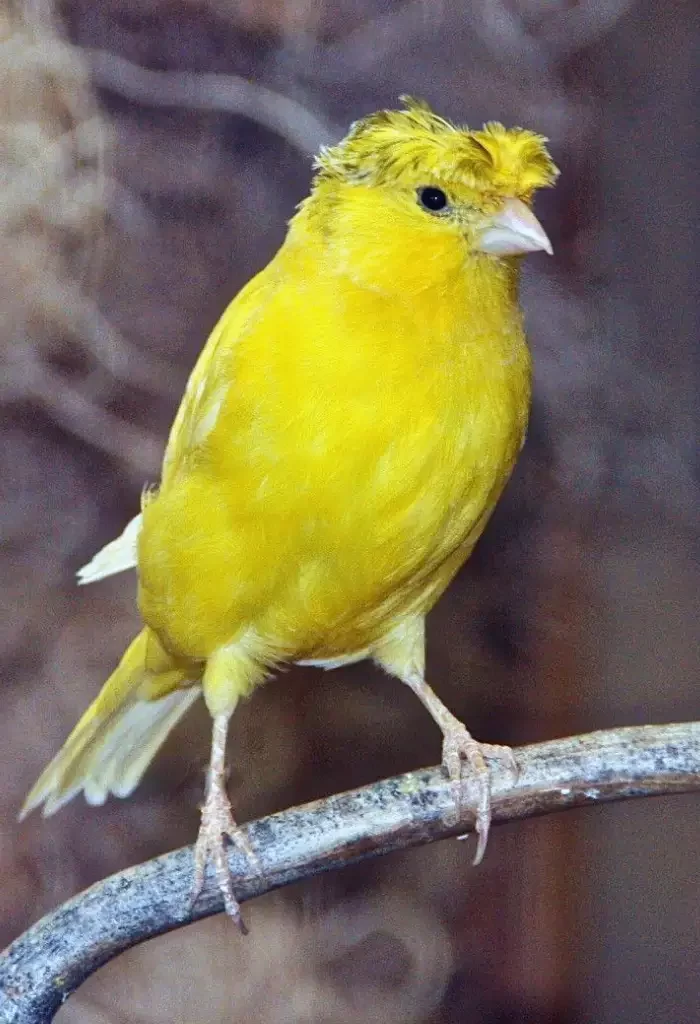
The roots of all domesticated Canaries, including the Crested variant, trace back to the wild canaries found in the Canary Islands, an archipelago located off the northwest coast of Africa. The name “canary” itself is derived from these islands. Wild canaries are mostly green, a far cry from the varied colors we see in domesticated versions today.
Arrival in Europe
It was in the late 16th and early 17th centuries that Canaries were brought to Europe, notably Spain and Italy. Their melodious song quickly made them popular, and bird enthusiasts began to selectively breed them to emphasize certain traits.
The Crested Canary emerged as a result of this selective breeding. As breeders aimed to produce birds with unique physical attributes, the crested mutation appeared. Over generations of deliberate breeding, this trait was enhanced, resulting in the distinct tuft of feathers we associate with the Crested Canary today.
Popularity and Further Breeding
The Crested Canary’s distinct appearance made it highly sought after. Over time, breeders began to cross them with other canary breeds, which led to the development of Crested Canaries in various colors and patterns.
Today, the Crested Canary remains a favorite among bird enthusiasts, not just for its charming crest but also for its spirited personality and song. They can be found in bird shows, pet stores, and the homes of bird lovers worldwide.
Physical Appearance: What does a crested canary look like?
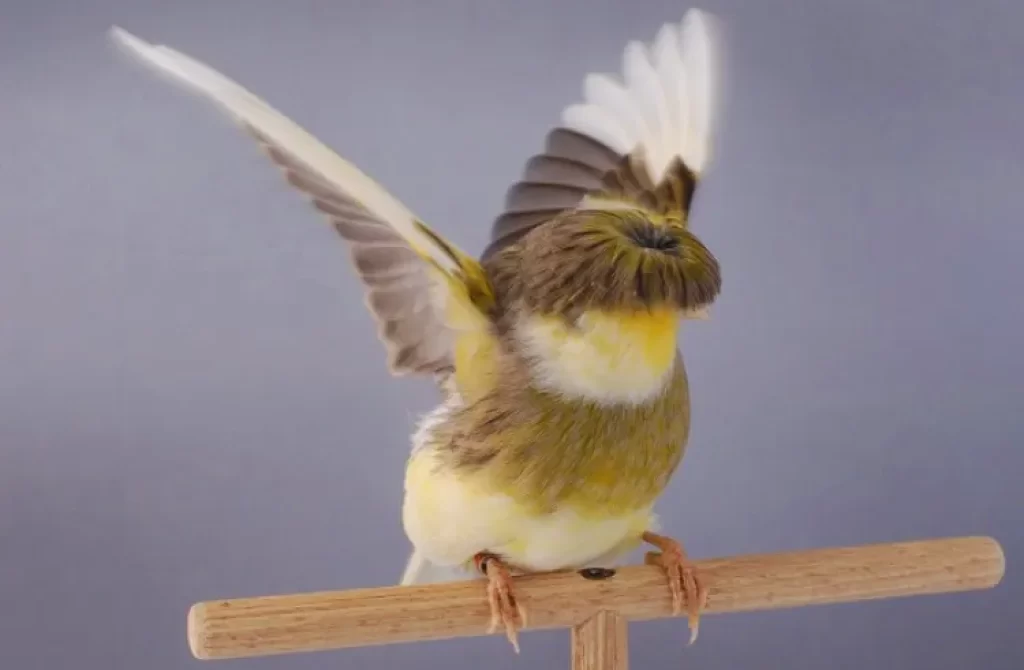
The crested canary, without a doubt, turns heads wherever it goes, and its most distinguishing feature is the tuft of feathers on its head. This remarkable ‘crest’ is reminiscent of a crown, and it has captured the attention of bird enthusiasts across the world.
The Crest
The crest’s formation is a result of a genetic mutation which causes the feathers on the bird’s head to grow upwards, creating this iconic look.
Depending on the individual bird, the crest can be large and pronounced, or more subtle and demure.
It can form a full circle or appear more like a half-moon shape, arching over the bird’s forehead. Regardless of its size and form, the crest invariably imparts a majestic and regal aura to the bird.
Body Structure
Moving beyond the crest, the crested canary boasts a body structure that is a testament to the classic canary build.
Their bodies are slender, reflecting their agile nature, and have a gentle roundness, especially around the chest area.
Their petite beaks are perfect for pecking at seeds, and their bright, inquisitive eyes reveal a world of curiosity.
Kaleidoscope of Colors
@darjane_canary gloster 💛🎶🥀#canari #canary #كناري #تغريد #canto #phaeo #mosaico #razaespañola #yorkshire #redfactorcanary #canary_gloster #recessivo ♬ الصوت الأصلي – darjane_canary
While many might picture the crested canary in a radiant shade of yellow, nature’s palette offers much more for this bird.
They can be found in pristine shades of white, which make their crest stand out even more prominently.
The greens range from soft pastels to deeper, more vibrant shades. Some crested canaries, due to selective breeding, even showcase hues of red, making them a fiery spectacle against the backdrop of their green habitats.
side note: From its signature crest to its rainbow of available colors, it’s no wonder that this bird remains a favorite among avian enthusiasts.
Temperament and Behavior: The Joyful Essence of the Crested Canary
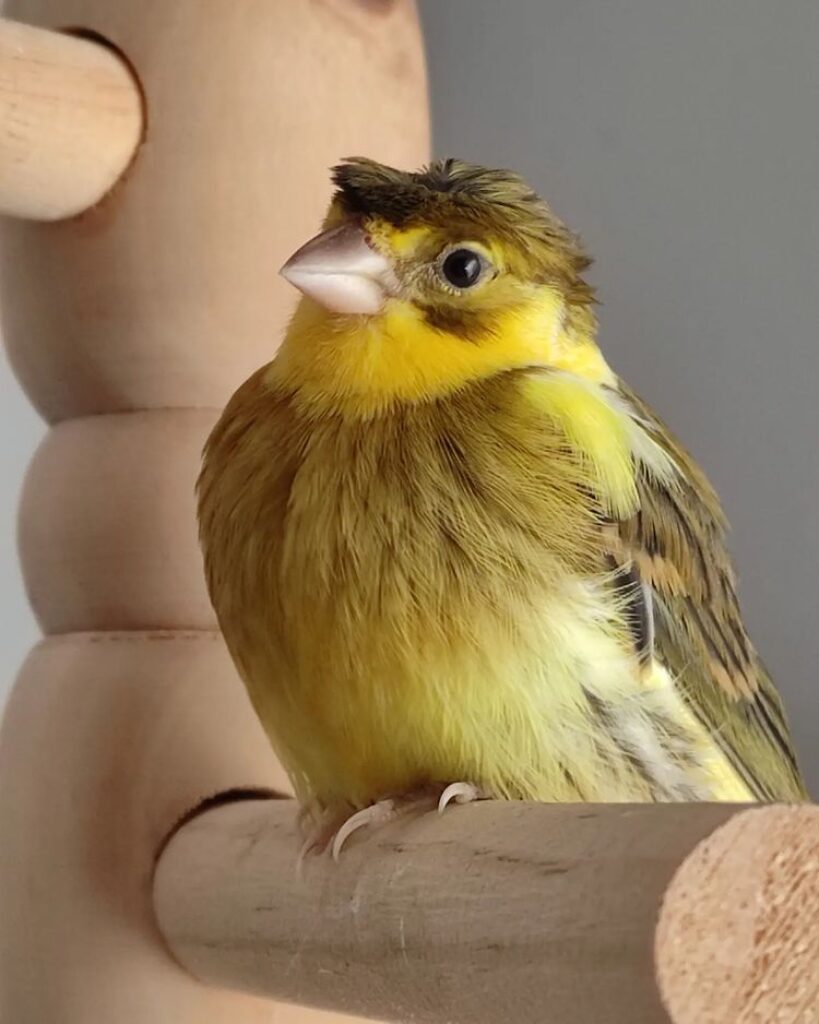
At the heart of every crested canary is a personality that radiates positivity and charm. Their behavior and temperament are deeply ingrained in their nature, and they seldom fail to bring a smile to anyone who interacts with them.
Sunny Disposition
One of the defining characteristics of the crested canary, like its other canary counterparts, is its inherently cheerful disposition.
These birds seem to have an innate ability to brighten up spaces with their presence. Their lively antics, playful nature, and curious attitudes make them delightful companions.
Sociability
While some birds might prefer solitude, the crested canary thrives in the company of its feathered friends.
They enjoy the hustle and bustle of flock dynamics and often engage in mutual preening, chirping conversations, and synchronized flying sessions.
This social nature is particularly evident in larger aviaries, where they effortlessly mingle and form tight-knit bonds with other birds.
Songbird Extraordinaire
Beyond their visual appeal, crested canaries are a treat for the ears. The male crested canaries, in particular, are known to produce songs that are not just melodic, but also incredibly varied in their notes and rhythms.
Each song is a symphony in its own right, echoing the bird’s emotions, surroundings, and experiences. The cascading notes, alternating pitches, and the occasional trills can be so captivating that many enthusiasts choose the crested canary primarily for this auditory delight.
A Bird of Many Talents
While their song is undoubtedly a highlight, crested canaries are also known for their playful antics.
Their curious nature often leads them to explore their surroundings, play with toys, and interact with their human caregivers.
This interactive behavior, combined with their musical talents, makes them an all-round entertaining pet.
Diet of the Crested Canary
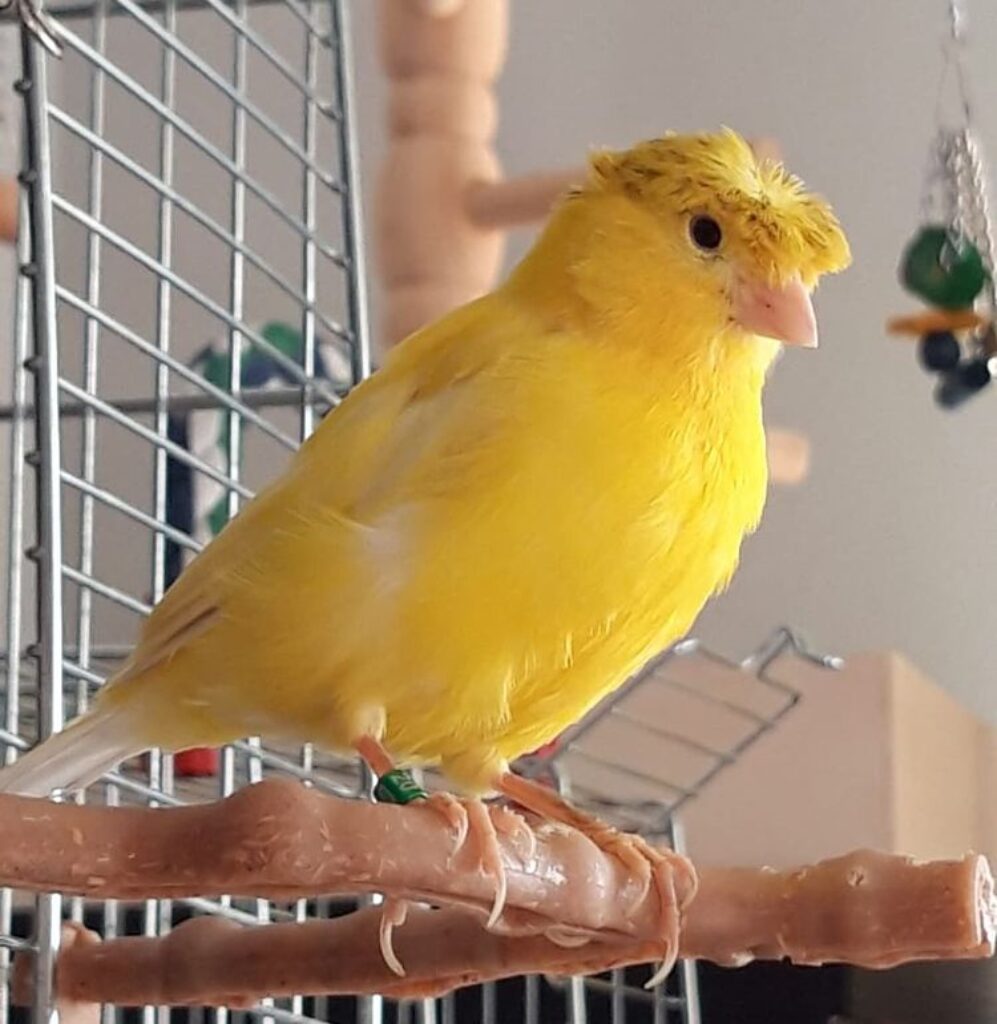
Crested canaries, like other canary breeds, thrive on a balanced and varied diet. Their dietary needs are essential to maintain their health, color, and vocal quality. Here’s a breakdown of what a well-rounded diet for a crested canary should include:
1. Seeds:
The staple of a crested canary’s diet is the Canary Seed Mix, consisting of canary grass seed, rapeseed, niger, linseed, and hemp.
Pellets are another option, providing a well-rounded blend of seeds and grains to ensure your bird gets essential nutrients. Some owners favor pellets for their convenience in minimizing waste and ensuring balanced nutrition.
2. Fresh Vegetables and Fruits:
When it comes to their diet, crested canaries enjoy a mix of foods. They primarily feed on seeds, with a typical seed mix including canary grass seed, rapeseed, niger, linseed, and hemp.
In addition to seeds, some owners choose to provide pellets, which are compressed forms of seeds and grains, ensuring a balanced intake of nutrients and reducing waste.
For a more varied diet, fresh vegetables like spinach, lettuce, dandelion leaves, kale, and broccoli can be offered.
These greens provide essential vitamins and minerals. As for fruits, occasional treats like apples, oranges, bananas, and berries are fine, but it’s crucial to remove any seeds, especially from apples, as they can be harmful. Providing this variety keeps your crested canary both healthy and content.
3. Protein Sources:
Crested canaries consume a variety of foods to stay healthy. Their primary diet consists of a seed mix, which typically includes canary grass seed, rapeseed, niger, linseed, and hemp. Pellets, compressed forms of seeds and grains, are also a valuable source of balanced nutrients.
To add variety and essential vitamins to their diet, crested canaries can enjoy fresh vegetables like spinach, lettuce, dandelion leaves, kale, and broccoli.
As for fruits, they can have apples, oranges, bananas, and berries in moderation, with seeds removed, especially apple seeds, which can be harmful.
Protein sources include egg food, a mixture of hard-boiled eggs, breadcrumbs, and greens, particularly important during molting and breeding. Occasional offerings of small insects like mealworms provide an extra protein boost.
4. Minerals and Supplements:
Crested canaries require certain minerals and supplements to maintain their health. Cuttlebone is a common addition to their diet, as it supplies essential calcium for bone health and egg development.
Mineral blocks are another valuable source of necessary minerals and trace elements that contribute to their overall well-being.
In cases where you believe your crested canary might not be receiving a fully balanced diet, it’s advisable to seek guidance from a veterinarian.
They can recommend vitamin drops that can be added to your canary’s water to ensure they get the necessary nutrients for optimal health.
5. Fresh Water:
Crested canaries, like all birds, require a consistent supply of fresh water for drinking. Ensure that their water dish is cleaned and refilled daily to keep it free from contaminants and debris.
Additionally, canaries enjoy bathing to keep their feathers clean and healthy. You can offer them a shallow dish of water a few times a week for this purpose.
Bathing not only helps with feather maintenance but can also be an enjoyable and refreshing activity for your feathered friend.
6. Treats:
Treats for crested canaries can include special seed treats, honey sticks, or millet sprays. However, these should be offered sparingly, as they shouldn’t constitute a significant part of their diet.
Treats can be used as occasional rewards or for added variety, but the primary diet of a crested canary should consist of seeds, pellets, fresh vegetables, fruits, and other essential nutrients to ensure their overall health and well-being.
Care and Maintenance
Taking care of a crested canary isn’t vastly different from other canary breeds. They require a spacious cage, fresh water, and a diet comprising seeds, greens, and occasional fruit.
Regular health check-ups, a clean environment, and attention to their social needs will ensure a happy and healthy bird. One unique aspect to consider is the care of their crest. A gentle misting can help keep their crest clean and vibrant.
Where to Adopt or Buy a Crested Canary
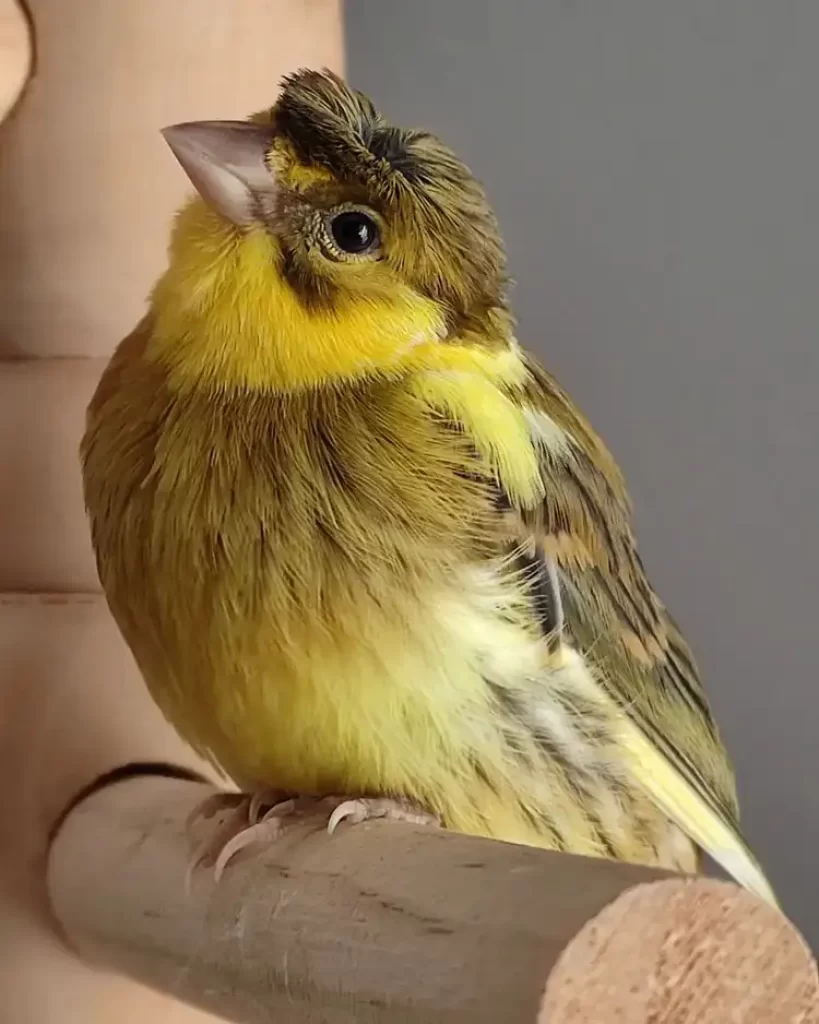
When it comes to bringing a crested canary into your life, you have a few avenues to explore:
Local Breeders
Start your search by reaching out to local breeders who specialize in canaries. These breeders often have crested canaries available and can provide valuable insights into their care, lineage, and unique characteristics.
Visiting a breeder allows you to personally observe the birds and their living conditions, ensuring you make an informed choice.
Aviaries and Bird Farms
Another great option is to explore aviaries and bird farms in your area. These facilities focus on breeding and raising various bird species, including crested canaries.
By visiting an aviary or farm, you can interact with the birds, assess their health and behavior, and choose the one that captures your heart.
Pet Stores
Some pet stores may carry a variety of canary breeds, including crested canaries. While convenient, it’s essential to carefully evaluate the store’s reputation and the conditions in which the birds are kept. Ensure that they are providing proper care and a healthy environment for their canaries.
Rescue Organizations
If you’re open to adoption, consider reaching out to bird rescue organizations or animal shelters. While crested canaries may be less common in rescue situations, adopting a bird in need can be a deeply rewarding experience. It’s an opportunity to provide a loving home for a bird that deserves a second chance.
Online Bird Marketplaces
Online platforms and bird marketplaces can also be a resource for finding reputable crested canary breeders.
However, exercise caution and thoroughly research the seller’s credibility and the well-being of their birds. Ask questions about the bird’s health, history, and breeding practices to ensure responsible ownership.
Regardless of your choice, always prioritize the well-being and ethical treatment of the bird. Ask for health records and any available history, and ensure the bird has been raised in a nurturing and caring environment.
Additionally, be aware of any local regulations or permits required for owning a crested canary, as these may vary by region.
What is special about created canaries?
Well, from my own experience having crested canaries as pets, I’d say they’re pretty special little birds. What really caught my eye is that tuft of feathers on their heads – it’s like they have a built-in crown! It gives them this regal and unique look that’s quite captivating.
But it’s not just their appearance that’s special; it’s their songs too. These little guys can really sing their hearts out. It’s amazing how such a small bird can produce such beautiful melodies.
Crested canaries are also friendly and sociable. They love the company of their human friends and enjoy chirping away, making them great companions.
@dekadenzia79 #glostercanary #gloster #fyp #fypシ #fy #bird #kanarienvogel #glosterkanarien ♬ Psycho Killer – Talking Heads
So, in my book, what makes crested canaries special is their charming appearance, melodious songs, and friendly personalities. They bring a lot of joy and beauty into your life! 😊
Conclusion
The crested canary is not just another bird; it’s an epitome of nature’s artistry with its stunning aesthetics and harmonious song.
Perfect for both seasoned bird enthusiasts and newcomers alike, this bird guarantees to be a cherished addition to any aviary. If you’ve been captivated by the charm of the crested canary, there’s a wealth of knowledge awaiting you on our website.
Dive deeper into our extensive collection of articles covering birds, plants, and the wonders of nature. Your journey into the mesmerizing world of nature has just begun, and there’s so much more to explore right here. So, before you go, don’t forget to bookmark our page and let nature’s beauty enchant you once more!
Crested Canary FAQ
What is a Crested Canary?
A Crested Canary is a specific breed of canary characterized by a distinctive crest of feathers on its head.
Where did the Crested Canary originate?
The Crested Canary is derived from wild canaries found in the Canary Islands, but it has been selectively bred for its unique crest.
How long does a Crested Canary live?
With proper care, a Crested Canary can live between 7 to 10 years, sometimes even longer.
What do Crested Canaries eat?
Their primary diet consists of seeds, but they also benefit from greens, fruits, and occasional protein sources like egg mix.
How do you distinguish a male from a female Crested Canary?
Generally, males are more vibrant in color and have a more melodious song. However, the surest way is through DNA testing or expert examination.
Can I keep multiple Crested Canaries together?
Yes, Crested Canaries can be social, but it’s essential to monitor them for signs of aggression, especially during breeding season.
Do Crested Canaries need any specific type of housing?
Crested Canaries require specialized housing to thrive. A spacious cage with ample toys, diverse perches, and quality nesting materials is essential. For their well-being, always ensure the cage is positioned in a location free from drafts and sudden temperature changes. Regular cleaning and maintenance are also crucial for their health.
How often should I clean the cage of a Crested Canary?
For the health and well-being of your Crested Canary, it’s essential to clean the cage thoroughly once a week. Additionally, daily spot cleaning of any waste or food debris will help maintain a clean environment. Regular maintenance ensures a hygienic habitat and keeps your bird healthy.
Are there any common health issues I should be aware of?
Yes, Crested Canaries can be prone to air sac mites, feather mites, egg binding, and respiratory issues. Regular vet check-ups are recommended.
Can I train my Crested Canary to perch on my hand or sing on command?
With patience and consistent training, many canaries, including the Crested variety, can be trained to perch on a hand or even respond to specific cues. However, making them sing on command might be more challenging and depends on the individual bird’s temperament.
Up next:
Kenno Marques is a self-taught English speaker deeply passionate about nature and wildlife. He dedicates his time to scouring the web for the latest animal news and engaging content, which he shares on various websites. Fluent in three languages, Kenno is currently on a journey to master German. His commitment to fostering an understanding of the natural world makes him a valuable contributor to the online community.





